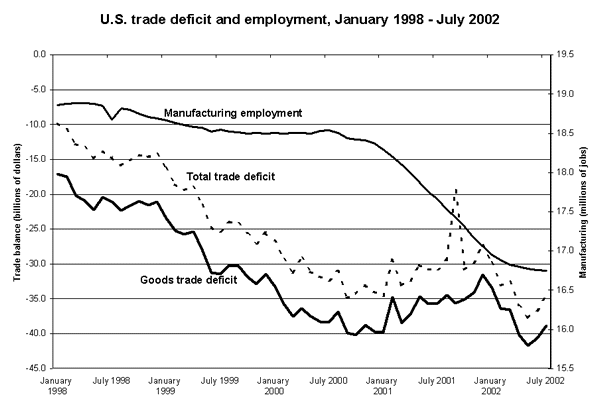A weekly presentation of downloadable charts and short analyses designed to graphically illustrate important economic issues. Updated every Wednesday.
Snapshot for September 25, 2002.
Disappearing manufacturing jobs and the trade deficit
Growing trade deficits have eliminated hundreds of thousands of jobs in the past three and a half years. After declining slightly in 2001, because of the recession, the trade deficit is surging again in 2002 and will probably exceed the record setting annual deficit in 2000.
If the trade deficit continues to grow, the crisis in manufacturing will intensify and could turn into wholesale collapse for major industries, with the U.S. steel industry being one of the hardest hit if the deficit continues to grow. Steel industries have lost more than 50,000 jobs since 1998, and 35 companies, representing nearly half of U.S. steel-making production capacity, have filed for bankruptcy.

While exports create jobs, imports also destroy them. The trade balance, that is, the difference between exports and imports, is the best measure of the impact of trade on the economy. The goods trade deficit-the most important measure of U.S. trade flows1-increased by $150 billion (or by a whopping 167%) between January and July 1998 and in the same period in 2002. In the same period, the U.S. lost 2.2 million manufacturing jobs. Although some of the jobs lost in manufacturing were caused by the recession, the majority resulted from the huge surge in the trade deficit in this period. The trade deficit has also reduced gross domestic product by at least two to three percentage points, because the trade balance (a growing deficit in this case) directly affects GDP. The Asian financial crisis and the overvaluation of the U.S. dollar have contributed to U.S. trade deficits. But the deficit has also grown steadily for the last three decades because foreign firms have dumped goods (like steel) in U.S. markets below cost and as a result of the flight of U.S. factories to countries where systematic exploitation and anti-worker policies have driven wages to less than $1 a day.
1. The goods trade balance has been nearly identical to the current account balance, the broadest measure of the U.S. trade deficit, for the last 20 years. A small surplus in services trade has been almost exactly offset by deficits in other payments, such as net income from foreign investments, foreign military aid, and gifts to family members in other countries.
This week’s Snapshot by EPI economist Robert E. Scott.
Check out the archive for past Economic Snapshots.
